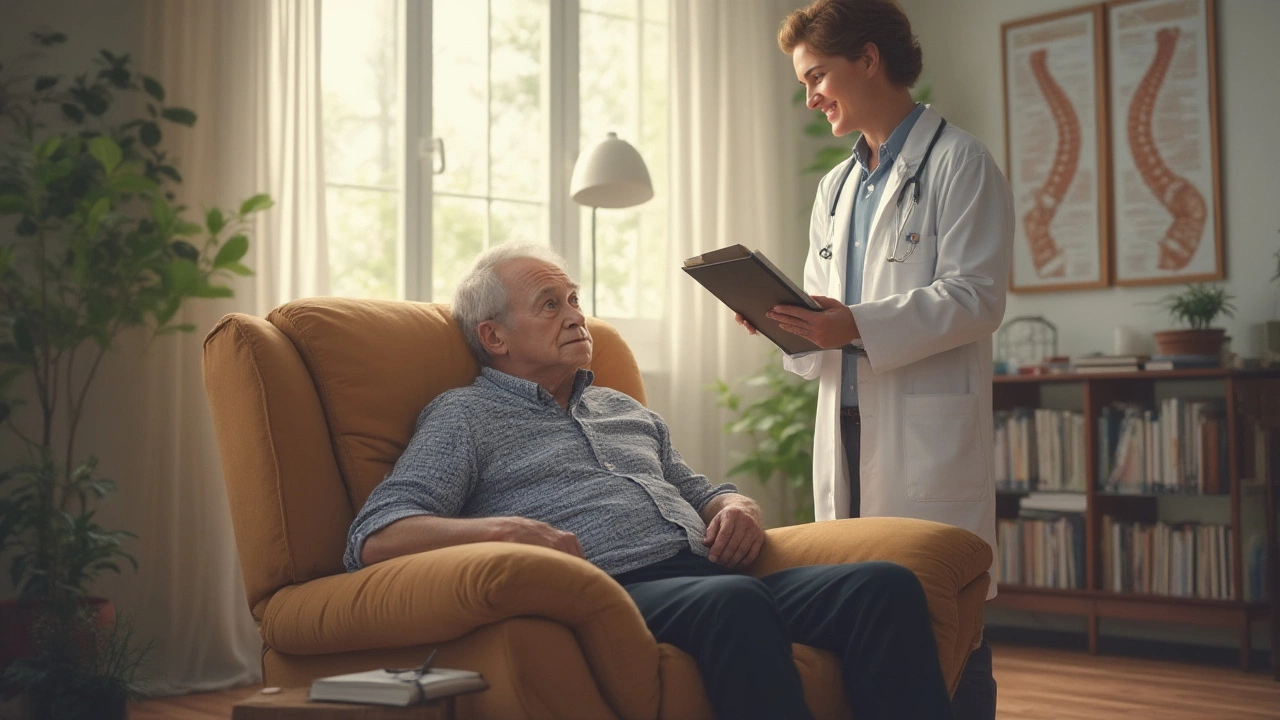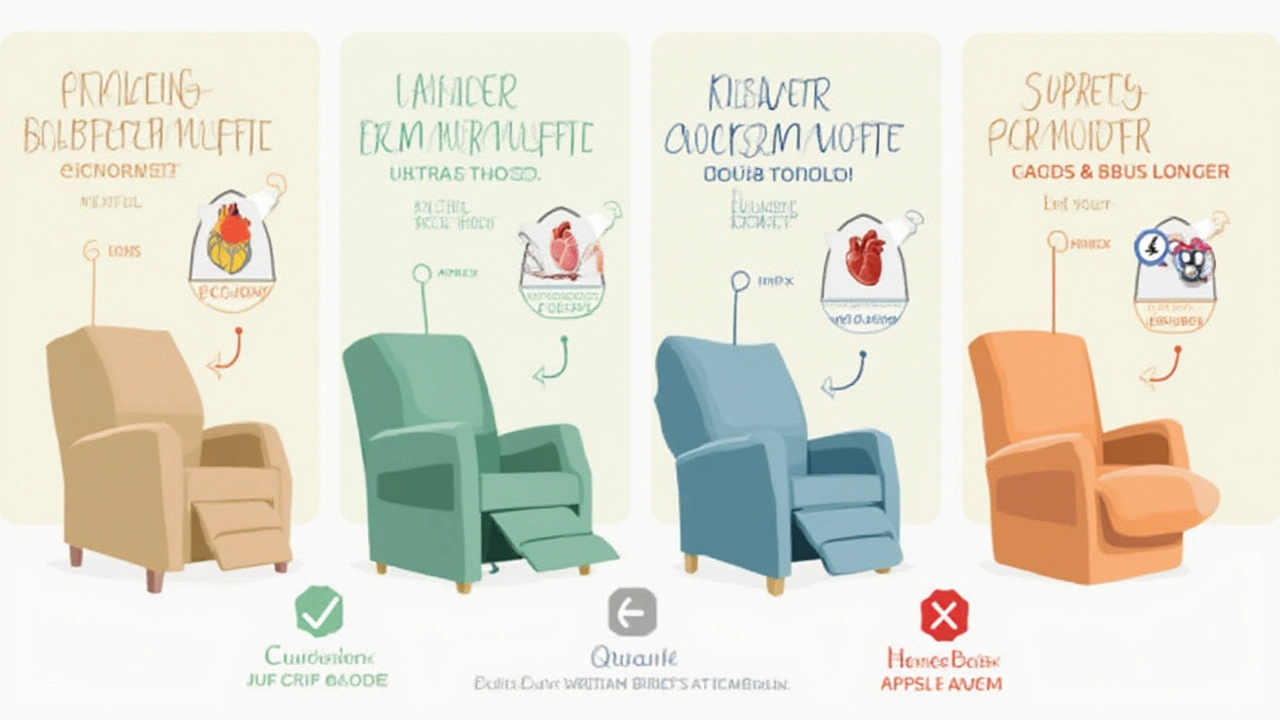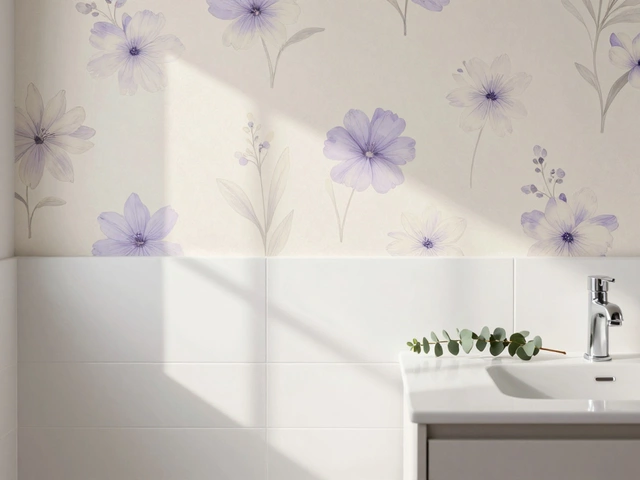
Imagine kicking back in your favorite chair after a long day. For lots of folks, that's a recliner—the big, cushy, kick-your-feet-up throne that somehow always calls your name during TV time or after work. But here’s the twist: a surprising number of people don’t just love their recliners for comfort; they swear these chairs ease pain and help with health problems. But does the science back that up, or is it just another cozy myth we want to believe?
What Do Doctors Really Think About Recliners?
When people talk about recliners and health, it usually starts with someone’s bad back, sore legs, or need to prop up swollen feet. You hear a lot of chatter online—grandparents, neighbors, and even my uncle—all saying “my doctor told me to use the recliner.” But what do real medical professionals say? The truth is, doctors look at the body’s comfort and support from a clinical angle. There isn’t a universal prescription where a recliner is handed out like, say, blood pressure meds. But in the right situation, with the right chair, doctors do offer real recommendations.
Take orthopedic surgeons for example. They see patients with chronic back pain, arthritis, or those recovering after surgeries. They often suggest seating positions that reduce pressure on the spine and promote circulation. For these patients, reclining at a gentle angle—usually between 110 and 130 degrees—can ease pain and help them heal. Some orthopedic clinics even display brochures of medical-grade recliners. And if you’ve ever had hip or knee replacement surgery, you probably heard a nurse suggest elevating your legs. Raising those legs above your heart helps circulate blood and cut down swelling, especially in the post-surgery days.
But there’s a caveat—a regular showroom recliner may not be the best match for everyone. Dr. Andrea Furlan, a physiatrist and pain specialist in Toronto, has said in interviews that comfort can’t come at the cost of proper alignment. Slumping too much or spending hours in a soft chair can actually strain the lower back and weaken core muscles if you’re not careful. The key, she says, is finding a recliner that supports good posture. So, doctors generally favor recliners if they support the body, not just cradle it like a worn-out hammock.
Heart specialists sometimes recommend reclined seating for folks with congestive heart failure or circulation problems. Laying flat can put pressure on the chest and make it tougher to breathe for these patients. That’s why adjustable beds and ergonomic recliners are often found in cardiac recovery rooms. And occupational therapists working with stroke or surgery patients will sometimes tell clients to use a reclining chair to relax sore muscles and change positions without strain.
So, do all doctors recommend recliners for everybody? Not quite. But experts in pain, heart health, and surgery recovery see their value when chosen carefully. It comes down to picking the right design and not overdoing lazy lounging.
Health Benefits of Using a Recliner
You might be surprised how many everyday aches and health conditions get a little better when you change the way you sit. When you’re upright in an ordinary chair, gravity pulls blood straight down, your spine stacks up with pressure, and you might even fidget from numbness. But a well-made recliner can flip the script in some pretty useful ways.
The first and maybe most obvious perk: pain relief. If you have lower back pain—a struggle for over 30 million Americans—reclining can take the pressure off those sensitive discs. Studies out of the University of Alberta showed that for patients with lumbar disc issues, even a small backward tilt helped reduce disc compression and pain. They felt more relaxed, too. When you lean back, you spread weight across a bigger area, so nothing gets pinched as tightly. Plus, with built-in lumbar support, the natural curve of your back can stay intact instead of flattening out like it does on many sofas or office seats.
Your legs benefit, too. Desk job? Swelling is a real thing, especially if you’re at a computer all day. Reclining lifts your legs up, so pooled fluid drains out and your veins get a break. That’s why physical therapists love the “feet higher than heart” trick. It’s handy for people with varicose veins, pregnancy swelling, or simply after standing on hard floors for hours. Some electric recliners now even include zero-gravity modes—a fancy-sounding feature that puts you in a NASA-designed position where your thighs and torso form a V, taking almost all pressure off your joints.
For anyone dealing with sleep apnea or acid reflux, sleeping flat just isn’t comfortable or safe. Doctors will sometimes suggest sleeping partially upright, which is where a recliner comes in handy, at least for naps. It keeps airways open and lessens nighttime coughs from acid coming up the esophagus. Recliners aren’t a replacement for a good bed, but they can bridge the gap if you have temporary issues or need to nap sitting up after a surgery.
Mental health gets a nod, too. Deep muscle relaxation, as you get from a supportive recliner, helps unwind the body and mind. People recovering from anxiety episodes, PTSD, or even chemotherapy have talked about feeling safer and more relaxed in a familiar reclining spot. Jasper, my cat, has definitely noticed this—whenever I melt into my recliner after a stressy day, he’s on my lap in seconds, ready to purr away the tension.
Recliners offer benefits, but each perk depends on how you use the chair, your health conditions, and, crucially, what kind of recliner you pick. The wrong one can mess up your back or legs, so the choices you make really matter.

Risks and Downsides: What Doctors Warn Against
Nothing’s perfect—especially in the world of super-soft furniture. Even with their benefits for pain, circulation, and stress, recliners come with risks if you misuse them or pick a model that doesn’t fit your body. That’s why physical therapists and spine doctors sometimes put the brakes on “all-day reclining.”
The biggest problem? Over-relaxing, believe it or not. Soft, unsupportive recliners might feel amazing at first, but hours spent slumped over can actually make back pain worse by flattening the lumbar curve and letting your muscles flip into lazy mode. Dr. Michael Gleiber, a Florida spine surgeon, says in various patient Q&As that “recliners without lumbar support are one of the main culprits behind aggravating chronic back pain for older adults.” If the seat pitch tips your hips too far back, your lower spine gets stretched and strained in weird ways. He even recommends that elderly patients use a small pillow or rolled towel to fill the lower back gap if the recliner is too soft.
Blood clots are another risk. The medical word is deep vein thrombosis (DVT). If you’re sitting without moving for more than a couple of hours, especially after having surgery, being pregnant, or if you have vascular problems, you’re more at risk for clots developing in your legs. That can be dangerous—if one travels to your lungs, it causes a pulmonary embolism, which is nothing to mess around with. If you’re using a recliner for post-surgery recovery, it’s smart to move your legs, do ankle circles, and stand up every hour or so, just like the nurses always nag (for good reason).
Sleeping all night in a recliner brings its own set of weird side effects. A study from the Cleveland Clinic noted that while napping in a recliner can help folks with breathing problems or back pain, spending months sleeping there is linked to lower limb swelling, neck stiffness, and even poor digestion. Some people wake up with soreness in odd places, like the tailbone or upper back, especially if the chair doesn’t cradle the body evenly.
Let’s not forget skin health. People who sit for long stretches—think elderly family members or those with mobility problems—risk pressure ulcers (bedsores) wherever the body presses against the chair, mainly the lower back and heels. That’s why medical-grade recliners meant for hospitals or care homes usually have ultra-soft padding and easy-to-clean fabrics. But a regular home recliner isn’t always up for the same job, especially if the user has poor sensation or circulation.
So, while recliners are great for many folks, you can harm your health if you’re not careful. Break up long periods of sitting, look for proper support, and avoid using the chair as a permanent bed. Doctors don’t hate recliners—but they’ll remind you every tool has its limits.
Tips for Choosing a Health-Friendly Recliner
Picking a recliner isn’t just about matching your curtains or scoring the softest model in the showroom. You need something that supports your unique body, lines up with your medical needs, and doesn’t turn into a body-molding sinkhole after six months. Here’s the advice I’ve picked up from doctors, physical therapists, and way too many hours measuring cushions at furniture stores.
- Doctors recommend recliners that give support right where your lower back curves (that’s called the lumbar region—think the spot just above your tailbone).
- Make sure your feet can touch the floor when the chair is upright, and that your knees are at about 90 degrees at the edge. This keeps circulation flowing and your legs from going numb.
- Try out the reclining action in the showroom. You should be able to operate the lever or button smoothly and without twisting your back. Electric or power models are handy if you have arthritis or mobility issues.
- Check the seat depth. If you’re tall, you want extra depth so your thighs are supported. If you’re shorter, padded footrests can make a world of difference.
- Look for “zero-gravity” or knee and leg support features if you have heart, back, or swelling issues. These positions take pressure off all your joints.
- Pick easy-clean fabrics, especially if this will be your post-surgery or recovery chair. Breathable material helps prevent skin irritation if you’ll spend hours in the seat (cats appreciate this part too, trust me—Jasper’s fluffy fur washes off easier on microfiber).
- If possible, try borrowing or renting a recliner for a week before buying. This lets you see how your body reacts with daily use. Some local pharmacies and medical supply stores actually offer rental recliners, especially in larger cities.
- Finally, consider adding a small lumbar pillow or wedge for extra back support, especially if you’re prone to slouching.
No two bodies are the same—your favorite chair might be a pain factory for someone else. So, take your time, and get comfy: choosing health-first usually means a bit of careful research and honest self-assessment.

What About Special Health Conditions?
This is where things get really personal, and where a good recliner can make—or mess up—your daily comfort. People struggling with chronic pain, surgery recovery, or serious illnesses often need extra help from their furniture. Doctors and occupational therapists get especially detailed with advice once specific conditions are involved.
For example, folks dealing with spinal stenosis, disc herniations, or arthritis in their hips or knees often do best in chairs that let them recline just enough to reduce pressure without folding the body up like a pretzel. For these people, a slight recline with good lumbar support decreases nerve pain and eases muscle spasms. Sometimes, physical therapists even coach patients on "recliner exercises"—little moves that keep joint stiffening and swelling at bay while they relax.
If you've had open-heart surgery or struggle with heart failure, sleeping flat often makes breathing harder, especially with fluid in the lungs. A recliner can make a recovery period more comfortable by letting users control the angle, stay semi-upright for easier breathing, and avoid coughing fits at night. Nurses often teach patients to move slowly in and out of the chair to avoid dizziness or blood pressure drops.
Swelling issues, like lymphedema or post-injury inflammation, call for power recliners with independent footrests. That way, legs can be propped up well above the heart to let extra fluid drain. Some specialty chairs even include slow massage rollers or gentle vibration to promote circulation—a feature that's been shown in small studies (like one in the Journal of Physical Therapy Science) to ease post-surgical swelling faster.
People rehabbing after joint surgery often need a chair high enough that getting in and out doesn't put stress on sore joints. Many hospital-sourced models have firm arms and adjustable seat heights—features that aren't as easy to find in regular retail shops. But for post-surgery needs, it’s worth the extra search.
Respiratory challenges, like sleep apnea or chronic obstructive pulmonary disease (COPD), also sometimes lead to doctor-approved “recliner naps.” With the right head support and open chest position, breathing feels easier and less strained—a big upgrade over trying to sleep propped up on pillows that never seem to stay put.
If you’re taking care of an older adult with memory loss or movement problems, safety features matter, too. Some recliners include anti-tip legs, push-button openers, and sturdy handles, making it easier and safer for seniors to transfer in and out on their own. Extra padding—especially on the sides—reduces bumps and bruises for folks who might slide in their seat or have difficulty judging space.
Whatever your condition, consult your doctor or physical therapist before picking a chair for serious recovery. They might even provide brand names or links to medical-grade suppliers, especially if insurance might cover some of the cost. Never treat a recliner as a fix-all for serious conditions—think of it as another helpful tool in your comfort toolbox.
There’s no denying it—recliners, when chosen well, can make a huge difference for people with certain health conditions or in certain life stages. But as with any good thing, moderation and mindful use matter just as much as the chair’s price tag.



